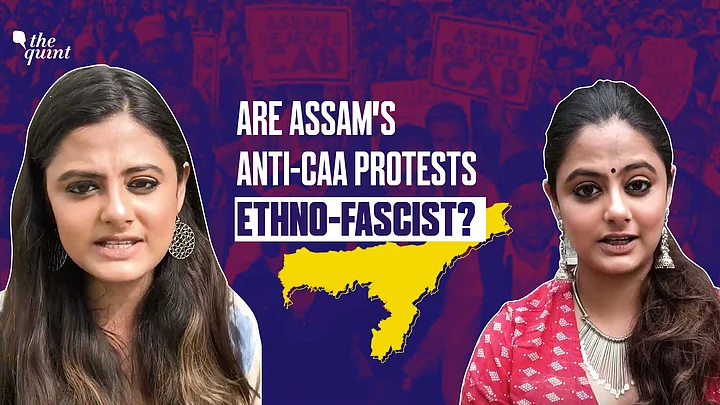Editor: Mohd. Ibrahim, Vivek Gupta
Assam was one of the states at the forefront of protests against Citizenship (Amendment) Bill, in 2019. As the Bill was passed and became law, protests over it are still unabated in the state.
However, over time many have said the anti-CAA protests in Assam try to maintain an ethnic Assamese majority over the state’s Bengali-speaking population – which the Assamese have defended as protection of identity.
So, which one is it? The Quint debates.
Why Were Assamese Silent During NRC Exercise?
The first argument put forth by many calling out Assamese anti-CAA protesters is that when the National Register of Citizens (NRC) exercise was conducted in Assam, many who are now protesting were silent.
Detractors say it’s because they felt NRC would identity the non-Assamese ‘outsiders’ who would subsequently be asked to leave the state. Then came CAA – saying Hindu immigrants would get citizenship. This meant Hindu immigrants from Bangladesh would be allowed to stay forever, and thus, fierce anti-CAA protests erupted across Assam.
Assamese protests, in argument, say though their reasons to protest are different than say, a Muslim person in Delhi, their fear being more cultural than demographic.
Why Are Areas In Assam Exempt From CAA Not Protesting?
Those calling the movement ethno-fascist also ask why the geographically, not all of Assam is protesting against the CAA? Why is it that some areas like Guwahati, Dibrugarh and Naogaon are seeing fierce protests while other areas like the Barak Valley, and other regions like Karbi Anglong, Dima Hasao and the other seven districts which have been exempted from the CAA are not protesting?
Those terming the movement ‘ethno-fascist’ further ask why, geographically speaking, all of Assam isn’t protesting against CAA. Why is it that areas like Guwahati, Dibrugarh and Naogaon are witnessing raging protests while areas like Barak Valley, Karbi Anglong, Dima Hasao and the other seven districts exempted from CAA are not?
In response, Assamese protesters emphasise that the protests are due to what is being seen as a breach of contract between Assamese people and central government.
The contract – Assam Accord of 1985 – was signed between the Rajiv Gandhi-led government and the leaders of Assam Movement. The movement, led by All Assam Students’ Union (AASU) and other regional parties, wanted the government to identify and deport “illegal immigrants” from the state. They too were scared and wanted the government to make legislative reforms for protection of their identity.
What were they scared of? Well, historically, since 19 Century, the Assamese have felt that the influx of migrants to the state, especially Bengali migrants, encouraged by the British, has upset the cultural and demographic balance of state.
For 37 years, the British even made Bengali the official language of Assam.
Partition in 1947 saw more Hindu Bengalis enter Assam. And even more entered the state in 1971 due to the violence surrounding the creation of Bangladesh.
So, the Assamese people’s fear and anger stems from a history of cultural oppression.
Nellie Massacre & ‘Bongal Kheda’
The non-Assamese, however, point out that the culture of oppression is not one-sided. They point to the Nellie Massacre of 1983 in which over 2,000 Bengali Muslims lost their lives and which is, till date, the bloodiest case of ethnic violence the state has experienced.
In fact, they say ‘Bongal Kheda’ or ‘Chase Away Bengalis’ movement started way back in 1948.
On the flip side – the Assamese say the Nellie Massacre was seen as a direct consequence of then Prime Minister Indira Gandhi granting voting rights to four million Bangladeshi immigrants. That, they remind, was vote-bank politics, which agitated the Assamese and promoted violence.
Who Is An ‘Indigenous Assamese’?
Those questioning the Assamese stance also ask why many like the Bengali Muslims, who have now co-opted Assamese culture, are still targeted.
To this, the Assamese say that this kind of co-option dilutes their identity. On the other hand, Bengali Hindus, who call Bengali their mother tongue, also bother the Assamese.
To make things even more complicated, there are ‘Assamese Muslims’ too and who is an ‘indigenous’ Assamese Muslim is a topic of debate in the state. In fact, when a list of these indigenous Muslims was drawn up by the state government recently, only four Muslim groups made it to the list.
Others, like the Miya Muslims, who migrated to Assam during the colonial times, have been excluded from the same.
Delhi Looking the Other Way?
The middle ground to solve a conflict as complicated as this cannot be detention centres of Foreigners Tribunals. It cannot be vote-bank politics either, which will only exacerbate ethnic insecurity.
The real way forward is to take cognisance of these nuanced problems that Assam faces and bring all the stakeholders together to solve them.
Basically, New Delhi and mainland India just need to stop, and for once, listen to what Assam and its people are saying.
(At The Quint, we question everything. Play an active role in shaping our journalism by becoming a member today.)
